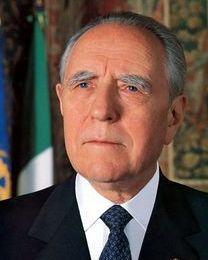Carlo Azeglio Ciampi Death
Carlo passed away on September 16, 2016 at the age of 95 in Rome, Italy.
When did Carlo Azeglio Ciampi die?
September 16, 2016How old was Carlo Azeglio Ciampi when died?
95Where did Carlo Azeglio Ciampi die? What was the location of death?
Rome, Italy
Carlo Azeglio Ciampi Birthday and Date of Death
Carlo Azeglio Ciampi was born on December 9, 1920 and died on September 16, 2016. Carlo was 95 years old at the time of death.
Birthday: December 9, 1920
Date of Death: September 16, 2016
Age at Death: 95
Carlo Azeglio Ciampi - Biography
Carlo Azeglio Ciampi (Italian pronunciation: [ˈkarlo adˈdzɛʎʎo ˈtʃampi] ( listen); born 9 December 1920) is an Italian politician and banker. He was the 49th Prime Minister of Italy from 1993 to 1994 and was the tenth President of the Italian Republic from 1999 to 2006. He is currently a Senator for life in the Italian Senate.Contents [hide] 1 Biography 1.1 Education1.2 Career in the Banca d'Italia1.3 Prime Minister2 President of Italy3 Awards and honours4 References Biography EducationCiampi was born in Livorno (Province of Livorno). After receiving a doctorate in literature in 1941 from the Scuola Normale Superiore di Pisa, one of the country's most prestigious universities, he was called to military duty in Albania as a lieutenant. On 8 September 1943, on the date of the armistice with the Allies, he refused to remain in the Fascist Italian Social Republic, and took refuge in Abruzzo, in Scanno. He subsequently managed to pass the lines and reach Bari, where he joined the Partito d'Azione (and thus the Italian resistance movement).In 1946 he married Franca Pilla. That same year, he obtained a doctorate in law from the University of Pisa and began working at the Banca d'Italia. He also joined the CGIL (Trade Union), which he left in 1980.Oxford University awarded him an honorary Doctor of Civil Law degree in March 2005. Career in the Banca d'ItaliaIn 1960, he was called to work in the central administration of the Banca d'Italia, where he became Secretary General in 1973, Vice Director General in 1976, and Director General in 1978. In October 1979, he was nominated Governor of the Banca d'Italia and President of the Ufficio Italiano Cambi, positions he filled until 1993. Prime MinisterFrom April 1993 to May 1994, he was the Italian Prime Minister overseeing a technical government. Later, as Treasury Minister from 1996 to May 1999 in the governments of Romano Prodi and Massimo D'Alema, he was credited with adopting the euro currency. He personally chose the Italian design for the 1-euro coin, whereas all others were left to a television vote among some candidates the ministry had prepared. (See also: Italian euro coins)Ciampi chose the Vitruvian man of Leonardo da Vinci, on the symbolic grounds that it represented man as a measure of all things, and in particular of the coin: in this perspective, money was at the service of man, instead of its opposite. The design also fitted very well on the bimetallic material of the coin. President of Italy Ciampi meets U.S. President in Quirinale Palace George W. Bush, April 7, 2005Ciampi was elected with a broad majority, and was the second president ever to be elected at the first ballot (when there is a requirement of a two-thirds majority) in a joint session of the Chamber of Deputies, the Italian Senate and representatives of the Regions.He usually refrained from intervening directly into the political debate while serving as President. However, he often addressed general issues, without mentioning their connection to the current political debate, in order to state his opinion without being too intrusive. His interventions have frequently stressed the need for all parties to respect the constitution and observe the proprieties of political debate. He was generally held in high regard by all political forces represented in the parliament. The possibility of persuading Ciampi to stand for a second term as President – the so-called Ciampi-bis – was widely discussed, despite his advancing age, but it was officially dismissed by Ciampi himself on 3 May 2006, just a few days before his mandate expired. Ciampi resigned as President before the swearing-in ceremony of his successor, Giorgio Napolitano.As President, Ciampi was not considered to be close to the positions of the Vatican and the Catholic Church, in a sort of alternance after the devout Oscar Luigi Scalfaro. He has often praised patriotism, not always a common feeling in Italy because of its abuse by the fascist regime; Ciampi, however, seems to want to stress self-confidence rather than nationalism.On 5 May 2005, he received the Charlemagne Award of the city of Aachen. On 15 June 2005, he was awarded an honorary doctorate by the École Normale Supérieure of Paris.On 1 May 2008, he attended Charlemagne Award of the city of Aachen. Awards and honoursThis article incorporates information from the equivalent article on the Italian Wikipedia.As President of the Italian Republic between 18 May 1999 and 15 May 2006, Ciampi held the roles of:Head of the Order of Merit of the Italian RepublicChief of the Military Order of ItalyHead of the Order of Merit for LabourHead of the Order of the Star of Italian SolidarityHead of the Order of Vittorio VenetoBailiff Grand Cross of Honour and Devotion of the Sacred Military Order of MaltaCollar of the Order of Pius IX (Papal Order)1982: Great Cross of the Order of Merit of the Italian Republic1985: Commander of the Legion of Honour (France)1986: Great Cross of Merit of the Federal Republic of Germany1993: Grand Cordon of the Order of the Rising Sun (Japan)1995: Freeman of the City of Naples1999: Collar of the Order of the White Rose (Finland)2000: Knight Grand Cross of the Order of the Bath (United Kingdom, 16 October 2000)2000: Knight Grand Cross of the Order of the White Eagle (Poland)2001: Knight Grand Cross of the Royal Norwegian Order of St. Olav2001: Grand Cross of the Grand Order of King Tomislav ("For outstanding contribution to the promotion of friendship and development co-operation between the Republic of Croatia and the Italian Republic." – Croatia, 19 October 2001)2001: Honorary doctorate from the University of Leipzig Faculty of Economics2002: Grand Star of Honour for Services to the Republic of Austria2002: - Grand Cross (or 1st Class) of the Order of the White Double Cross (Slovakia) 2002: Grand Collar of the Order of Prince Henry (Portugal, 22 February 2002)2002: Grand Cross with Collar of the Order of Merit of the Hungarian Republic2002: Collar Pro Merito Melitensi of the Sovereign Military Order of Malta2003: Collar of the Order of the Star of Romania2004: Collar of the Order of the Cross of Terra Mariana (Estonia)2004: Commander Grand Cross with Chain of the Order of Three Stars (Latvia)Honorary Member of the Xirka Ġieħ ir-Repubblika (Malta, 19 May 2005)2005: Charlemagne Prize2005: - Grand Cross of the Order of Saint-Charles (Monaco, 13 December 2005) Grand Cross of the Order of the Southern Cross (Brazil)2008: Honorary doctorate from the Economics Faculty of the University of AugsburgAwarded honorary doctorates of various universities, including the University of Oxford (2005








